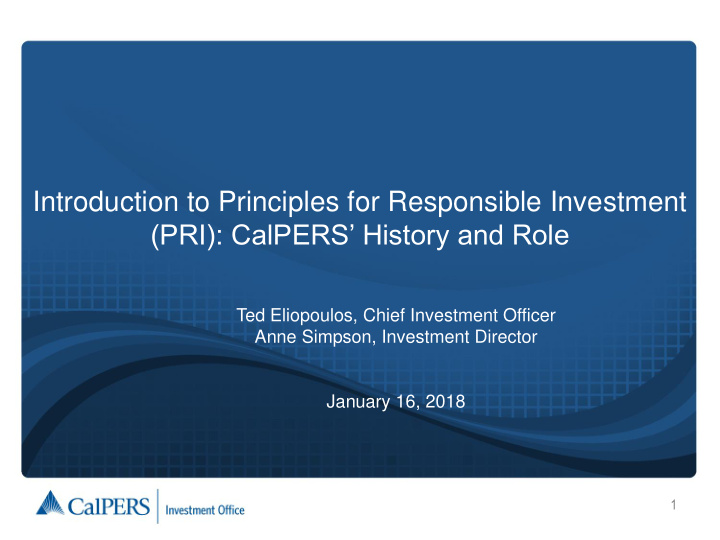



Introduction to Principles for Responsible Investment (PRI): CalPERS’ History and Role Ted Eliopoulos, Chief Investment Officer Anne Simpson, Investment Director January 16, 2018 1
PRI | CalPERS’ History and Role • Early 2005: Invited by UN Secretary-General to join an investor working group to develop set of global best-practice principles for responsible investment • Coordinated by the United Nations Environment Programme Finance Initiative (UNEP FI) and the UN Global Compact • March 2006: Investment Committee voted to become one of original signatories to PRI • April 2006: Principles were publicly launched, with signing ceremony at the New York Stock Exchange • 32 institutional investors, representing over $2Trillion in AUM, formally signed the principles • CalPERS publicly committed to adopt and implement, where consistent with its fiduciary responsibilities • CalPERS continues to be represented on the UN PRI Board 2
PRI | Six Principles Principle #1: We will incorporate ESG issues into investment analysis and decision-making processes Possible Actions: Address ESG issues in investment policy statements • • Support development of ESG-related tools, metrics, and analyses Assess the capabilities of internal investment managers to incorporate ESG issues • Assess the capabilities of external investment managers to incorporate ESG issues • • Ask investment service providers (such as financial analysts, consultants, brokers, research firms, or rating companies) to integrate ESG factors into evolving research and analysis • Encourage academic and other research on this theme Advocate ESG training for investment professionals • Source: https://www.unpri.org/about/the-six-principles 3
PRI | Six Principles Principle #2: We will be active owners and incorporate ESG issues into our ownership policies and practices Possible Actions: Develop and disclose an active ownership policy consistent with the Principles • Exercise voting rights or monitor compliance with voting policy (if outsourced) • • Develop an engagement capability (either directly or through outsourcing) Participate in the development of policy, regulation, and standard setting (such as • promoting and protecting shareholder rights) File shareholder resolutions consistent with long-term ESG considerations • Engage with companies on ESG issues • • Participate in collaborative engagement initiatives Ask investment managers to undertake and report on ESG-related engagement • Source: https://www.unpri.org/about/the-six-principles 4
PRI | Six Principles Principle #3: We will seek appropriate disclosure on ESG issues by the entities in which we invest Possible Actions: Ask for standardised reporting on ESG issues (using tools such as the Global Reporting • Initiative) • Ask for ESG issues to be integrated within annual financial reports Ask for information from companies regarding adoption of/adherence to relevant norms, • standards, codes of conduct or international initiatives (such as the UN Global Compact) Support shareholder initiatives and resolutions promoting ESG disclosure • Source: https://www.unpri.org/about/the-six-principles 5
PRI | Six Principles Principle #4: We will promote acceptance and implementation of the Principles within the investment industry Possible Actions: • Include Principles-related requirements in requests for proposals (RFPs) Align investment mandates, monitoring procedures, performance indicators and incentive • structures accordingly (for example, ensure investment management processes reflect long-term time horizons when appropriate) Communicate ESG expectations to investment service providers • • Revisit relationships with service providers that fail to meet ESG expectations Support the development of tools for benchmarking ESG integration • • Support regulatory or policy developments that enable implementation of the Principles Source: https://www.unpri.org/about/the-six-principles 6
PRI | Six Principles Principle #5: We will work together to enhance our effectiveness in implementing the Principles Possible Actions: • Support/participate in networks and information platforms to share tools, pool resources, and make use of investor reporting as a source of learning • Collectively address relevant emerging issues Develop or support appropriate collaborative initiatives • Source: https://www.unpri.org/about/the-six-principles 7
PRI | Six Principles Principle #6: We will each report on our activities and progress towards implementing the Principles Possible Actions: • Disclose how ESG issues are integrated within investment practices Disclose active ownership activities (voting, engagement, and/or policy dialogue) • • Disclose what is required from service providers in relation to the Principles Communicate with beneficiaries about ESG issues and the Principles • Report on progress and/or achievements relating to the Principles using a ’Comply or • Explain’[1] approach Seek to determine the impact of the Principles • • Make use of reporting to raise awareness among a broader group of stakeholders [1] The Comply or Explain approach requires signatories to report on how they implement the Principles, or provide an explanation where they do not comply with them. Source: https://www.unpri.org/about/the-six-principles 8
PRI | Annual Reporting Consistent with Principle #6, CalPERS reports annually on the following: Category Description Organisational Overview Basic information Strategy and Governance Polices, procedures, partnerships Indirect- Manager Selection, Similar to Manager Expectations, covers all asset classes Appointment and Monitoring Direct- Listed Equity Integration in to Public Equity investment decisions Incorporation Direct- Listed Equity Active Engagement in Public Equity Ownership Direct – Fixed Income Integration and engagement in Fixed Income 9
PRI | 2017 PRI Assessment Source: PRI Assessment Report 2017 California Public Employees’ Retirement System CalPERS 10
Recommend
More recommend